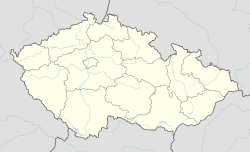Dobrá (Frýdek-Místek District)
| Dobrá | |||
|---|---|---|---|
| Village | |||

Saint George Church
|
|||
|
|||
| Coordinates: 49°40′24″N 18°24′48″E / 49.67333°N 18.41333°ECoordinates: 49°40′24″N 18°24′48″E / 49.67333°N 18.41333°E | |||
| Country | Czech Republic | ||
| Region | Moravian-Silesian | ||
| District | Frýdek-Místek | ||
| First mentioned | 1305 | ||
| Government | |||
| • Mayor | Alice Tancerová | ||
| Area | |||
| • Total | 8.72 km2 (3.37 sq mi) | ||
| Elevation | 332 m (1,089 ft) | ||
| Population (2006) | |||
| • Total | 2,997 | ||
| • Density | 340/km2 (890/sq mi) | ||
| Postal code | 739 51 | ||
| Website | www |
||
Dobrá (Polish: Dobra, German: Dobrau) is a village in the Frýdek-Místek District, Moravian-Silesian Region of the Czech Republic. It has 2,997 inhabitants (2006). It lies on the Morávka River, in the historical region of Těšín Silesia. The village is nowadays known for the big Hyundai factory which has been being built in Nošovice, a village nearby.
The settlement was first mentioned in a Latin document of Diocese of Wrocław called Liber fundationis episcopatus Vratislaviensis from around 1305 as item in Dobroczemicza. It meant that the village was in the process of location (the size of land to pay a tithe from was not yet precised). The creation of the village was a part of a larger settlement campaign taking place in the late 13th century on the territory of what will be later known as Upper Silesia.
Politically the village belonged initially to the Duchy of Teschen, formed in 1290 in the process of feudal fragmentation of Poland and was ruled by a local branch of Piast dynasty. In 1327 the duchy became a fee of Kingdom of Bohemia, which after 1526 became part of the Habsburg Monarchy.
The village became a seat of a Catholic parish, mentioned in the register of Peter's Pence payment from 1447 among 50 parishes of Teschen deaconry as Dobersey.
...
Wikipedia



